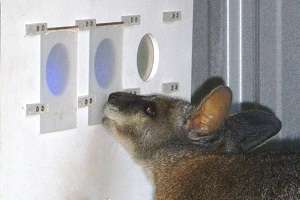Tammar wallaby has a form colour vision similar to that of dogs

New research has confirmed the tammar wallaby (Macropus eugenii) has a form of colour vision that is more similar to that of dogs rather than to other animals of similar species.
Curtin University's Dr Wiebke Ebeling and UWA's Associate Professor Jan Hemmi recently published their findings in "Dichromatic Colour Vision in Wallabies as Characterised by Three Behavioural Paradigms".
Trichromatic colour vision, like in humans, is based on three cone photoreceptor types, allowing the perception of colour at a higher resolution and over a larger range. Dichromatic systems, like in dogs, contain only two cone types.
Dr Ebeling says they've now confirmed the tammar wallaby is a dichromat—unlike its close relative the trichromatic quokka.
She says more work is required to re-confirm trichromatic colour vision in a number of other marsupial species.
The study was conducted via three experiments; LCD colour-mixing, wavelength discrimination, and examination of the 'neutral point'.
For example, the wavelength discrimination experience examined the wallaby's capacity to tell the difference between two wavelengths out of a range; from quite different to very similar, to indicate how many "spectrally distinct photoreceptors contribute to colour perception".
According to the study, "when tested with monochromatic stimuli, wavelength discrimination ability in the wallaby found was limited to a narrow range between 440nm and 500nm", as opposed to trichromats whose range of good discriminability is much broader.
Finally, neutral point experiments revealed the point at which the wallaby cannot distinguish between a particular wavelength and a broadband white light.
However, Dr Ebeling says what is most curious is that, while the wallaby is a dichromat, it is still not known what the additional photoreceptor in other marsupials is and how it evolved so that they may see colour, nor why the wallaby "missed out".
Dr Ebeling says that from an evolutionary perspective, the most plausible scenario why we are still lacking genetic evidence of a third cone type in marsupials would be if they possessed a "hybrid" photoreceptor that was a morphological cone (i.e. "wired up" and used for colour vision), but one which also contained rhodopsin, the pigment of "colour-blind" rods in a retina (used for low light vision).
"That scenario would have conveniently explained why there was no need for an additional cone photopigment," she says.
However, Dr Ebeling's previous experiments have not pointed to such a 'hybrid'.
More information: Ebeling W, Hemmi JM (2014) Dichromatic Colour Vision in Wallabies as Characterised by Three Behavioural Paradigms. PLoS ONE 9(1): e86531. DOI: 10.1371/journal.pone.0086531
Journal information: PLoS ONE
Provided by Science Network WA

















